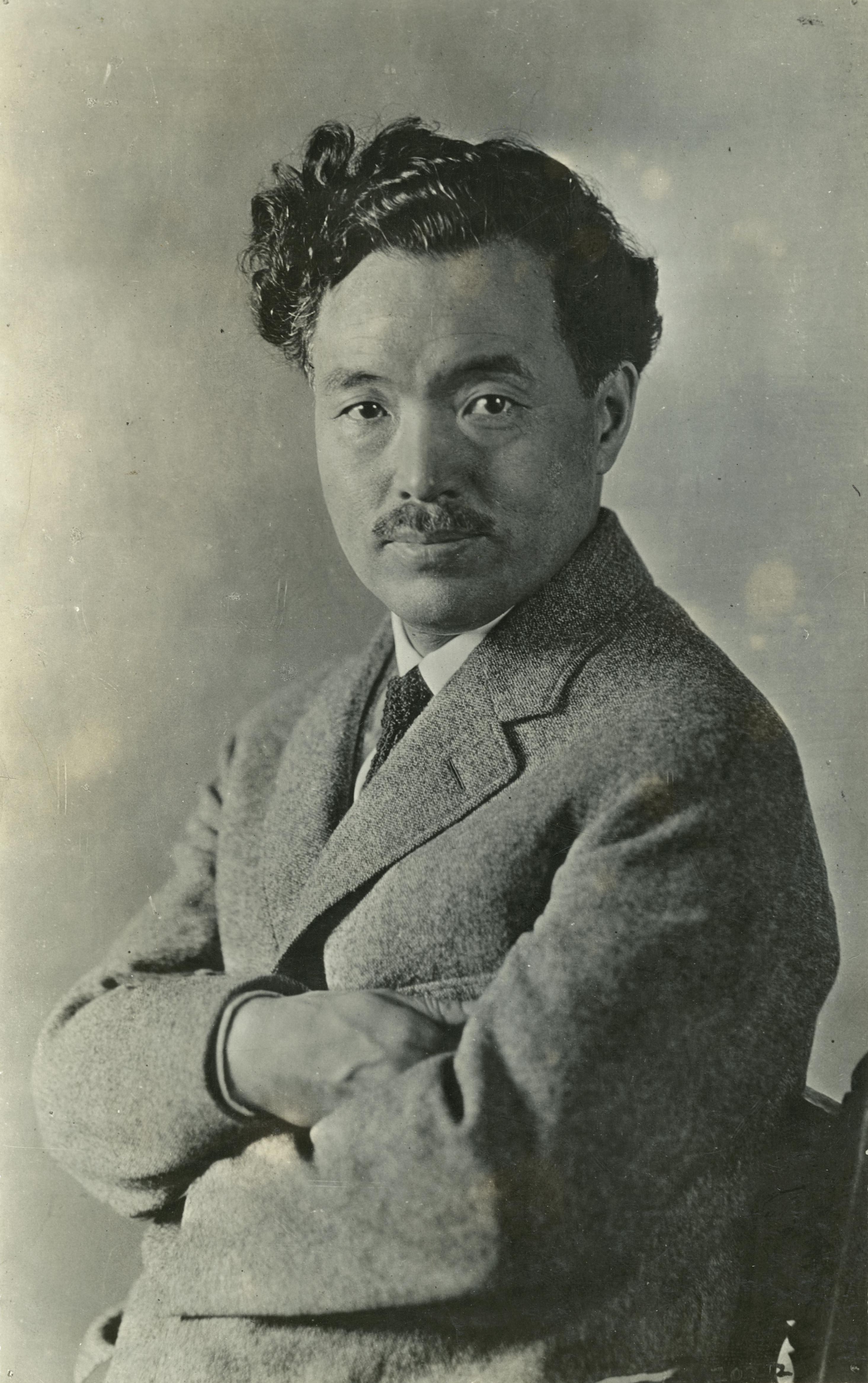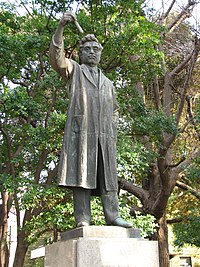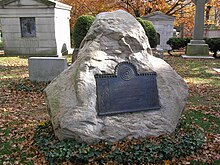
Early life
Noguchi Hideyo was born in Inawashiro, Fukushima prefecture in 1876. When he was one and a half years old he fell down into a fireplace and suffered a burn injury on his left hand. There was no doctor in the small village, but one of the men examined the boy. "The fingers of the left hand are mostly gone," he said, "and the left arm and the left foot and the right hand are burned; I know not how badly."
In 1883 he entered Mitsuwa elementary school. Thanks to generous contributions from his teacher Kobayashi and his friends, he was able to receive surgery on his badly burned left hand. He recovered about 70% mobility and functionality in his left hand through the operation.
Noguchi decided to become a doctor to help those in need. He apprenticed himself to Dr. Kanae Watanabe (渡部 鼎 Watanabe Kanae?), the same doctor who had performed the surgery on his hand. He entered Saisei Gakusha that later became Nippon Medical School. He passed the examinations to practice medicine when he was twenty years old in 1897. He showed signs of great talent and was supported in his studies by Dr. Morinosuke Chiwaki. In 1898, he changed his first name to Hideyo after reading a novel about a doctor who had the same name - Seisaku - as him. The doctor in the novel was intelligent like Noguchi, but became lazy and ruined his life.
Career
In 1900 Noguchi moved to the United States, where he obtained a job as a research assistant with Dr. Simon Flexner at the University of Pennsylvania and later at the Rockefeller Institute of Medical Research. He thrived in this environment.At this time his work concerned poisonous snakes. In part, his move was motivated by difficulties in obtaining a medical position in Japan, as prospective employers were concerned about the impact the hand deformity would have on potential patients. In a research setting, this handicap became a non-issue. He and his peers learned from their work and from each other. In this period, a fellow research assistant in Flexner's lab was Frenchman Alexis Carrel, who would go on to win a Nobel Prize in 1912;[2] and Noguchi's work would later attract the Prize committee's scrutiny. The Nobel Foundation archives have been only recently opened for public inspection; and what was once only speculation is now confirmed. He was nominated for the Nobel Prize in Physiology or Medicine in 1913-1915, 1920, 1921 and 1924-1927.
While working at the Rockefeller Institute of Medical Research in 1913, he demonstrated the presence of Treponema pallidum (syphilitic spirochete) in the brain of a progressive paralysis patient, proving that the spirochete was the cause of the disease. Dr. Noguchi's name is remembered in the binomial attached to another spirochete, Leptospira noguchii.
In 1918, Noguchi traveled extensively in Central America and South America to do research for a vaccine for yellow fever, and to research Oroya fever, poliomyelitis and trachoma. He believed that yellow fever was caused by spirochaete bacteria instead of a virus, and spent much of the next ten years attempting to prove this theory. His work on yellow fever was widely criticized as taking an inaccurate approach which was contradicting contemporary research, and confusing yellow fever with other pathogens. In 1927-28 three different papers appeared in medical journals which discredited his theories. Happily, it turned out he had confused yellow fever with leptospirosis, and his "yellow fever" vaccine was successfully used to treat the latter disease.

Death
In 1928, Noguchi traveled to Africa in an attempt to prove his findings about yellow fever. While working in Accra, Gold Coast (modern-day Ghana) he died from yellow fever on May 21, 1928,his last words being "I don't understand.

Noguchi is still famous for his pioneering work, although later research was not able to reproduce many of his claims including having discovered the causes of polio, rabies, syphilis, trachoma, and yellow fever. In part, this was due to the early stage of research on such diseases, as virology and bacteriology were not fully separated until the appearance of electron microscopes. In 1928, when Noguchi died: "the nature of any filterable virus (was)... entirely unknown and the group of virus diseases...was loosely held together by the threat of filterability of the active agents. To be fair, one should accept that he conducted his research on yellow fever at a period in which virology itself was not defined and delienated." Noguchi's most famous contribution is his identification of the causative agent of syphillis (the bacteria Treponema pallidimn) in the brain tissues of patients suffering from partial paralysis due to meningoencephalitis. Other lasting contributions include the use of snake venom in serums, the identification of the leishmaniasis pathogen and of Carrion's disease with Oroya fever. Cricitisms of his work are that: His finding that Noguchia granulosis causes trachoma was questioned within a year of his death, and overturned shortly thereafter. His identification of the rabies pathogen was wrong,] because the medium he invented to cultivate bacteria was seriously prone to contamination. Overall, Noguchi's contribution should be evaluated by the methods and laboratories available then.
Selected works
1904: The Action of Snake Venom Upon Cold-blooded Animals.
Washington, D.C.: Carnegie Institution. [OCLC 2377892]
1909: Snake Venoms: An Investigation of Venomous Snakes with Special Reference to the Phenomena of Their Venoms.
Washington, D.C.: Carnegie Institution. [OCLC 14796920]
1911: Serum Diagnosis of Syphilis and the Butyric Acid Test for Syphilis.
Philadelphia: J. B. Lippincott. [OCLC 3201239]
1923: Laboratory Diagnosis of Syphilis: A Manual for Students and Physicians.
New York: P. B. Hoeber. [OCLC 14783533]
Honors during Noguchi's lifetime
Noguchi was honored with both Japanese and foreign decorations. He received honorary degrees from a number of universities.
He was self-effacing in his public life, and he often referred to himself with naive objectiveness, as "funny Noguchi;" but those who knew him well reported that he "gloated in honors." When Noguchi was awarded an honorary doctorate at Yale, William Lyon Phelps observed that the Kings of Spain, Denmark and Sweden had conferred awards, but "perhaps he appreciates even more than royal honors the admiration and the gratitude of the people."
Kyoto Imperial University - Doctor of Medicine, 1909.
Order of Dannebrog, 1913 (Denmark).
Order of Isabella the Catholic, 1913 (Spain).
Order of the Polar Star, 1914 (Sweden).
Tokyo Imperial University - Doctor of Science, 1914.
Order of the Rising Sun, Gold Rays with Rosette, 1915.
Imperial Award, Imperial Academy (Japan) - 1915.
Central University of Ecuador, 1919 - (Ecuador).
National University of San Marcos, 1920 - (Peru)
Medicine School of Merida - "Doctor Honoris Causa en Medicina y Cirugía", 1920 - (México)
University of Guayaquil, 1919 - Ecuador.
Yale University, 1921 - (United States).

Noguchi's remains were returned to the United States and buried in New York City's Woodlawn Cemetery.
In 1928, the Japanese government awarded Noguchi the Order of the Rising Sun, Gold and Silver Star, which represents the second highest of eight classes associated with the award.
In 1979, the Noguchi Memorial Institute of Medical Research (NMIMR) was founded with funds donated by the Japanese government. The Institute is located at the University of Ghana in Legon, a suburb north of Accra.
Dr. Noguchi's portrait has been printed on Japanese 1000 yen banknotes since 2004.[28] In addition, the house where he was born and brought up is preserved and is part of a museum to his life and its achievements near Inawashiro.
Noguchi's name is honored at the Centro de Investigaciones Regionales Dr. Hideyo Noguchi at the Universidad Autónoma de Yucatán.
Human experimentation
In 1911 and 1912 at the Rockefeller Institute in New York City, Noguchi was working to develop a syphilis skin test similar to the tuberculin skin test. The subjects were recruited from clinics and hospitals in New York. In the experiment, Noguchi injected an extract of syphilis called luetin under the subjects' upper arm skin. Skin reactions varied among healthy subjects and syphilis patients by the disease's stage and its treatment. Of the 571 subjects, 315 had syphilis. The remaining subjects were "controls" who did not have syphilis and were orphans or hospital patients. The hospital patients had nonsyphilitic diseases, such as malaria, leprosy, tuberculosis, and pneumonia. Finally, of the controls, were normal individuals, mostly children between the ages of 2 and 18 years. Critics at the time noted that Noguchi violated the rights of orphans and hospital patients.
In Noguchi's defense, Rockefeller Institute business manager Jerome D. Greene wrote a letter to the anti-vivisection society which had protested the experiment. Greene pointed out that Noguchi had tested the extract on himself before administering it to subjects, and his fellow researchers had done the same. Nevertheless, in May 1912 the New York Society for the Prevention for Cruelty to Children asked the New York district attorney to press charges against Noguchi; he declined.
ไม่มีความคิดเห็น:
แสดงความคิดเห็น